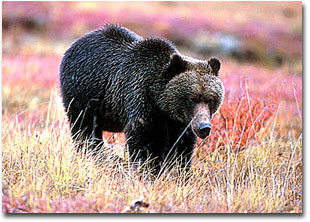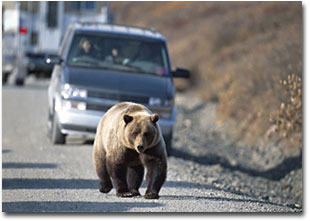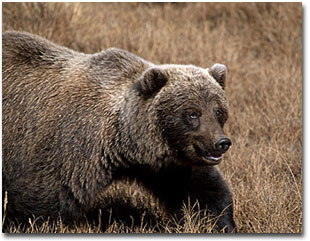|
The Camera Hunter®
Photography and Text Copyright Bill Silliker, Jr.
All rights reserved.
The elk herd suddenly stopped grazing. As if by a much rehearsed plan, one adult elk after another looked up and sniffed the air. Their alert poses made you wonder what it was that had them so spooked. Following their eyes, I looked towards the distant forest edge.
 Grizzly!
Grizzly!
There was no doubt about it. The bear stood silhouetted by the green of the hillside, where a large aspen grove met the open terrain of Yellowstone National Park's Lamar Valley. The hump on the bear's shoulders showed clearly.
A large bison feeding on the same hillside offered a contrasting silhouette as it faced the bear. Neither of the two animals displayed concern as they stared at each other. And no wonder: a grizzly would think twice before taking on a healthy mature bison.
An adult cow elk snorted an alarm and the herd scurried towards higher ground. Some had to cross Cache Creek to get off of the open meadow. The young calves among them splashed along behind their mothers. The herd then gathered together, with the mature elk circling the recently born.
The grizzly knew it had been spotted. As it watched the scene play out, I wondered what it might be thinking.
By then I'd photographed the bear, the bear and the bison and the gathering elk herd from my distant position a thousand feet or so from the big bear. As tempting as it was to step farther out into that meadow, I knew better. A grizzly bear can run at least 35 miles per hour. That's probably three times faster then I'd ever be able to run. No, I'd have to be content with the images I'd made using a 2X teleconverter on a 400mm lens.
Perhaps the bear would give up on the elk herd. Would it then come out onto the meadow to graze on emerging spring grass or search for ground squirrels? What should I do if it did? How close should I let the bear get before heading for the car? I thought about closing the distance to the bear by just a few hundred feet. No, I told myself again. You don't approach a grizzly on foot. Other photographers have done that and paid with their lives.
While the odds of being done-in by a grizzly are far less than that of being killed by lightening, approaching one on foot just dosen't make sense, not to mention violates National Park Service regulations. And approaching one that must be hungry after emerging from a long winter's sleep into a just greening-up world would be about as sane as standing on a golf course in a raging thunderstorm while raising an umbrella with a metal point atop it towards the sky to see what might happen.

Risk is inherent in all that we do, but some activities obviously involve more risk than others - like approaching a grizzly bear! The pictures in hand would have to do. There's a rule often quoted for ethical wildlife photographers, one that says no photograph is worth endangering the life of your subject or yourself. Nowhere is it more approriate to remember that maxim than when you see a distant grizzly bear and you want to get closer for a good photograph of it. While I didn't get any images of this event worth showing here, I did learn a lot about self control.
A better opportunity would come someday. But first I'd have to learn more about these legendary predators: where to find them; what behavior to expect from them; how to behave to minimize the chances for a dangerous encounter and more. I'd need to know what they ate, and where and when; where they slept; their mating behavior; and how they reared their cubs. Most of all I'd need to learn how to get close enough to safely capture on film one of nature's most formidable and feared species. You have to develop an informed respect for such an animal before you can hope to regularly do that.
Whether or not they set out with the intent of capturing a grizzly bear on film, camera hunters should know something about them if they plan to shoot in brown bear country. Why? Because if one spends enough time in the woods, sooner or later they're going to run into a grizzly bear. How much do you know about grizzly bears? Here's a quick quiz -
- What's the average home range of a grizzly bear?
- How many cubs does a mother grizzly usually have?
- How long do grizzly cubs stay with their mother?
- Does male grizzlies help in bringing up the young?
- When are grizzlies born?
- When do grizzlies come out of their dens?
- Where are you most apt to encounter a grizzly?
- Who's more dangerous to encounter at close range by surprise: a mother grizzly with cubs or a big boar with a carcass?

Professional wildlife photographers want a subject they can work with. They're not much interested in a "grab shot". They want rolls of film, shooting different poses from different angles with horizontal and vertical framing. When you're talking grizzly bears, that requires that you go to the special places where the bears are somewhat habituated and have a good food supply so that they're not interested in you as a food source.
A final note: the behavior of the bears that you encounter as you pursue camera hunting is the responsibility of both those individual bears and you. Never assume that because you read or heard something that it is "safe to do this or that" to get a picture of a grizzly, or in fact, of a black bear either. You should be aware that you could be in danger whenever you are in close proximity to any bear, anywhere.
CAMERA HUNTER QUIZ ANSWERS
- A grizzly's range depends completely on food availability. Food rich area bears ranged from about 20 to 40 square miles in one study, while bears in a Yellowstone study had home ranges as great as 318 square miles!
- Two is the average number, with some mothers having only one cub, and with some having three or even four cubs occasionally.
- Usually for two winters after their birth. Some may stay with their mother for three years, like a group of three very big cubs I photographed in Denali NP a few years ago. And yes, mother was still wary about anything or anyone getting close to her youngsters.
- No, in fact a male will try to kill any cubs he meets, usually with the idea of eating them.
- In January in the den.
- In May, as the earth "greens" up.
- Anywhere in grizzly country where a good food supply exists
- It doesn't matter: either one will try to kill you.
Catch yours in the good light.
BS-NPN
Maine wildlife & nature photographer Bill Silliker, Jr. – The Mooseman - photographed at many wild places in North America, with the results published in magazines internationally and in 9 of his own books. Bill was an instructor of wildlife and nature photography for L. L. Bean's Outdoor Discovery Program and a member of the Fuji Film Talent Team. Read more about Bill on the Camera Hunter archives page.


| 


